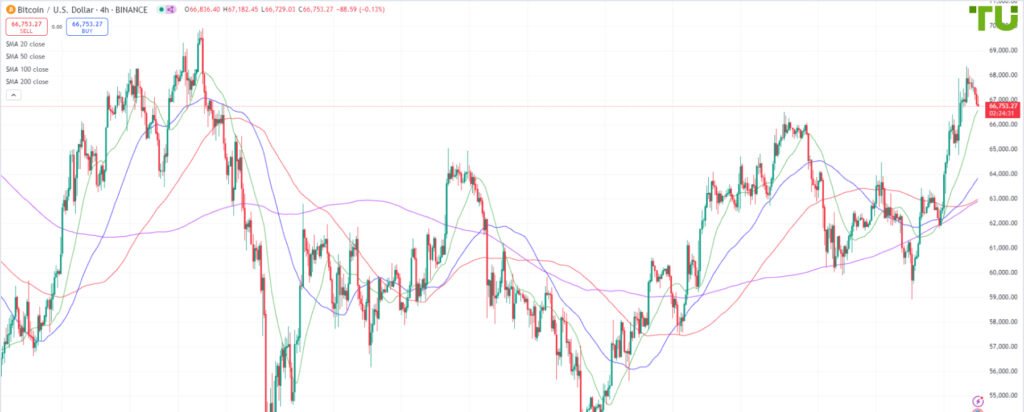Bitcoin (BTC) continues to dominate the cryptocurrency market, serving as a benchmark for the entire digital asset ecosystem. The BTC USD Price fluctuates based on various economic, technical, and market-driven factors. Investors and traders closely monitor Bitcoin’s price to make informed decisions regarding buying, selling, or holding the asset.
In this article, we will explore the latest BTC USD price trends, historical performance, key influencing factors, expert predictions, and what the future holds for Bitcoin in the global financial market.
Understanding BTC USD Price Fluctuations
The BTC USD price is highly volatile and can experience rapid fluctuations within short timeframes. Several factors contribute to this volatility, including market demand and supply, macroeconomic conditions, regulatory developments, institutional interest, and technological advancements.
Unlike traditional currencies, Bitcoin operates on a decentralized blockchain network, meaning its value is determined by market participants rather than a central authority. Traders and investors often analyze BTC price charts, technical indicators, and market trends to predict future movements.
Historical Performance of BTC USD Price
Bitcoin has experienced significant price movements since its inception in 2009. Here are some key milestones:
- 2010-2012: Bitcoin started with a negligible value, reaching its first notable price point of $1 in 2011.
- 2013: BTC surged to $1,000 for the first time, driven by growing adoption and media attention.
- 2017: Bitcoin reached an all-time high of nearly $20,000 before a market correction.
- 2020-2021: Institutional interest fueled BTC’s rise to a new all-time high of around $69,000 in November 2021.
- 2022: Market downturns and macroeconomic factors led to price declines, bringing Bitcoin below $20,000 at some points.
- 2023-Present: Bitcoin showed signs of recovery, fluctuating between $30,000 and $50,000 as institutional adoption increased.
Factors Influencing BTC USD Price
Several key factors influence Bitcoin’s price movements, shaping investor sentiment and market trends:
1. Market Demand and Supply
Bitcoin’s supply is capped at 21 million coins, making it a scarce digital asset. As demand increases, so does the price. Halving events, which reduce mining rewards, also contribute to Bitcoin’s deflationary nature and price appreciation over time.
2. Institutional Adoption
Major financial institutions, hedge funds, and corporations have started investing in Bitcoin, legitimizing it as a store of value. Companies like Tesla, MicroStrategy, and PayPal have played a crucial role in boosting Bitcoin’s mainstream adoption.
3. Macroeconomic Factors
Global economic conditions, inflation rates, interest rate policies, and currency devaluations significantly impact Bitcoin’s price. During economic downturns, Bitcoin is often seen as a hedge against inflation and a store of value.
4. Regulatory Developments
Government policies, cryptocurrency regulations, and legal frameworks can either boost or hinder Bitcoin’s price. Positive regulations encourage institutional investment, while restrictive policies can lead to market sell-offs.
5. Technological Advancements
The development of Bitcoin’s network, including upgrades like the Lightning Network and Taproot, enhances its efficiency, security, and scalability. Technological improvements positively influence investor confidence.
6. Market Sentiment and Media Influence
Public perception, social media trends, and media coverage affect Bitcoin’s price movements. Positive news can drive demand, while negative sentiment can lead to short-term declines.
Expert Predictions on BTC USD Price

Industry experts and analysts regularly provide predictions on Bitcoin’s future price based on market trends and economic indicators. Some experts predict Bitcoin could reach new all-time highs in the coming years, while others highlight potential risks and corrections.
Bullish Predictions
- Analysts at Bloomberg and JP Morgan suggest that Bitcoin could surpass $100,000 within the next decade due to increasing adoption and limited supply.
- Crypto influencers like PlanB (creator of the Stock-to-Flow model) project Bitcoin reaching $250,000 in the long term.
Bearish Predictions
- Some financial analysts warn of regulatory hurdles, economic downturns, and potential market corrections that could drive BTC prices below key support levels.
- If market conditions deteriorate, Bitcoin could revisit lower price ranges before stabilizing.
Future Outlook for BTC USD Price
The future of Bitcoin remains highly speculative, but several key trends suggest a promising outlook:
- Increased Institutional Interest: More companies and financial institutions are expected to integrate Bitcoin into their portfolios, driving demand.
- Mainstream Adoption: Countries like El Salvador have adopted Bitcoin as legal tender, and more nations may follow suit.
- Technological Improvements: Continued advancements in Bitcoin’s scalability and security will enhance its usability and appeal.
- Regulatory Clarity: Clearer cryptocurrency regulations could provide a stable environment for long-term Bitcoin investment.
Conclusion
Various factors, including market demand, institutional interest, macroeconomic conditions, and regulatory policies influence the BTC USD price. While Bitcoin remains a volatile asset, its potential for long-term growth is undeniable. Investors should stay informed about market trends, conduct thorough research, and assess risks before making investment decisions.
As the cryptocurrency market evolves, Bitcoin’s price trajectory will likely be shaped by technological innovations, economic trends, and global adoption. Whether bullish or bearish, the BTC USD price remains a key indicator of the digital currency revolution.
Read more: XRP: The Future of Digital Payments and Blockchain Innovation


